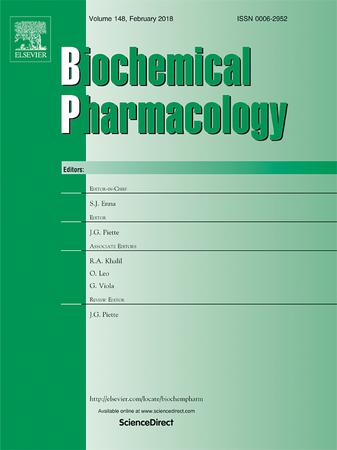The function of microRNA related to cancer-associated fibroblasts in pancreatic ductal adenocarcinoma
IF 5.3
2区 医学
Q1 PHARMACOLOGY & PHARMACY
引用次数: 0
Abstract
Pancreatic ductal adenocarcinoma (PDAC) is a highly lethal malignant tumor characterized by a poor prognosis. A prominent feature of PDAC is the rich and dense stroma present in the tumor microenvironment (TME), which significantly hinders drug penetration. Cancer-associated fibroblasts (CAFs), activated fibroblasts originating from various cell sources, including pancreatic stellate cells (PSCs) and mesenchymal stem cells (MSCs), play a critical role in PDAC progression and TME formation. MicroRNAs (miRNAs) are small, single-stranded non-coding RNA molecules that are frequently involved in tumorigenesis and progression, exhibiting either oncolytic or oncogenic activity. Increasing evidence suggests that aberrant expression of miRNAs can mediate interactions between cancer cells and CAFs, thereby providing novel therapeutic targets for PDAC treatment. In this review, we will focus on the potential roles of miRNAs that target CAFs or CAFs-derived exosomes in PDAC progression, highlighting the feasibility of therapeutic strategies aimed at restoring aberrantly expressed miRNAs associated with CAFs, offering new pathways for the clinical management of PDAC.

与癌相关成纤维细胞相关的microRNA在胰腺导管腺癌中的作用
胰腺导管腺癌(PDAC)是一种高致死率、预后差的恶性肿瘤。PDAC的一个突出特征是肿瘤微环境(TME)中存在丰富而致密的基质,这显著阻碍了药物的渗透。癌症相关成纤维细胞(CAFs),来自各种细胞来源的活化成纤维细胞,包括胰腺星状细胞(PSCs)和间充质干细胞(MSCs),在PDAC进展和TME形成中起关键作用。MicroRNAs (miRNAs)是一种小的单链非编码RNA分子,经常参与肿瘤的发生和进展,表现出溶瘤或致癌活性。越来越多的证据表明,mirna的异常表达可以介导癌细胞与CAFs之间的相互作用,从而为PDAC治疗提供了新的治疗靶点。在这篇综述中,我们将重点关注靶向CAFs或CAFs衍生外泌体的mirna在PDAC进展中的潜在作用,强调旨在恢复与CAFs相关的异常表达mirna的治疗策略的可行性,为PDAC的临床管理提供新的途径。
本文章由计算机程序翻译,如有差异,请以英文原文为准。
求助全文
约1分钟内获得全文
求助全文
来源期刊

Biochemical pharmacology
医学-药学
CiteScore
10.30
自引率
1.70%
发文量
420
审稿时长
17 days
期刊介绍:
Biochemical Pharmacology publishes original research findings, Commentaries and review articles related to the elucidation of cellular and tissue function(s) at the biochemical and molecular levels, the modification of cellular phenotype(s) by genetic, transcriptional/translational or drug/compound-induced modifications, as well as the pharmacodynamics and pharmacokinetics of xenobiotics and drugs, the latter including both small molecules and biologics.
The journal''s target audience includes scientists engaged in the identification and study of the mechanisms of action of xenobiotics, biologics and drugs and in the drug discovery and development process.
All areas of cellular biology and cellular, tissue/organ and whole animal pharmacology fall within the scope of the journal. Drug classes covered include anti-infectives, anti-inflammatory agents, chemotherapeutics, cardiovascular, endocrinological, immunological, metabolic, neurological and psychiatric drugs, as well as research on drug metabolism and kinetics. While medicinal chemistry is a topic of complimentary interest, manuscripts in this area must contain sufficient biological data to characterize pharmacologically the compounds reported. Submissions describing work focused predominately on chemical synthesis and molecular modeling will not be considered for review.
While particular emphasis is placed on reporting the results of molecular and biochemical studies, research involving the use of tissue and animal models of human pathophysiology and toxicology is of interest to the extent that it helps define drug mechanisms of action, safety and efficacy.
 求助内容:
求助内容: 应助结果提醒方式:
应助结果提醒方式:


